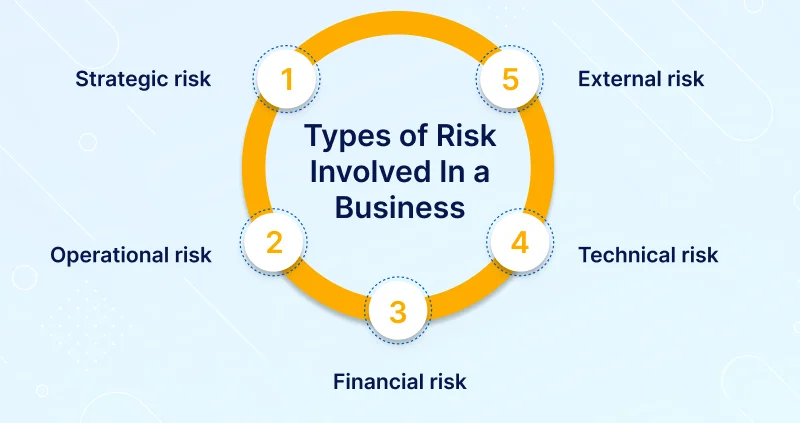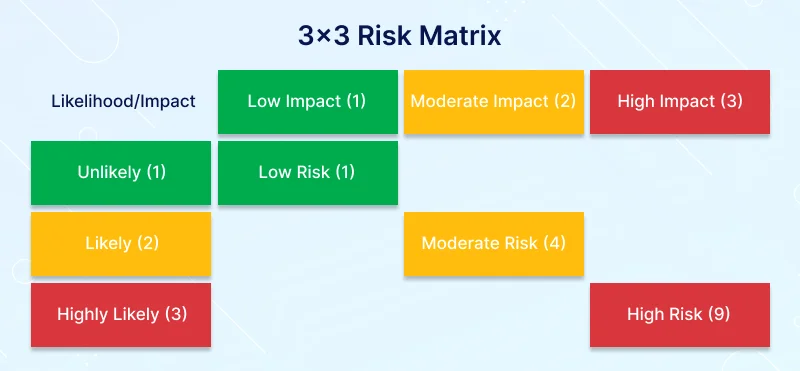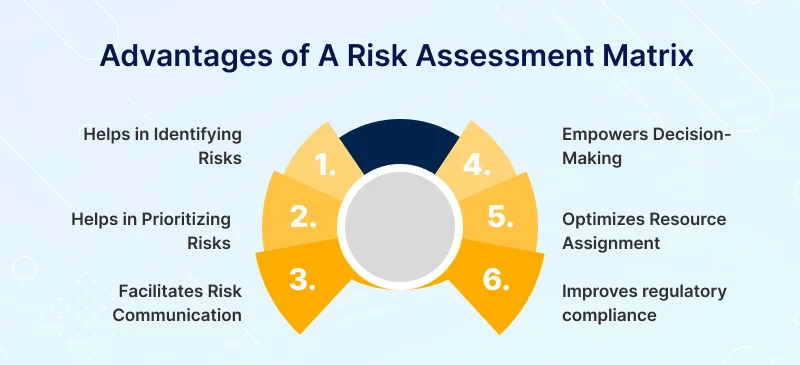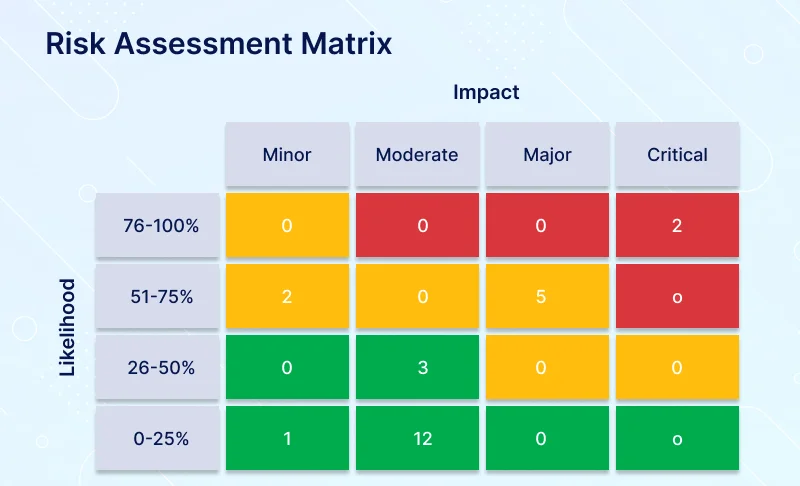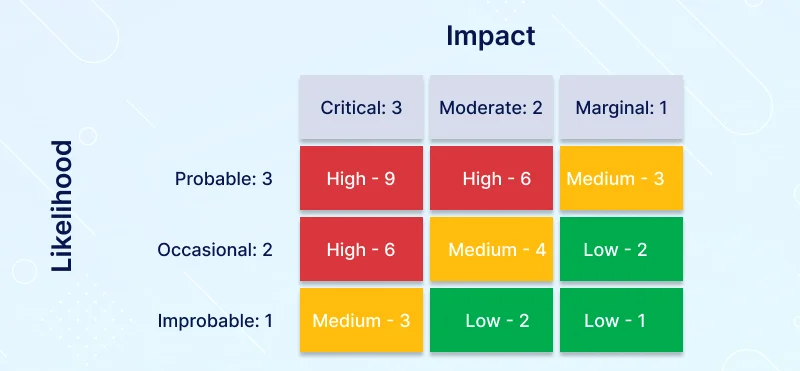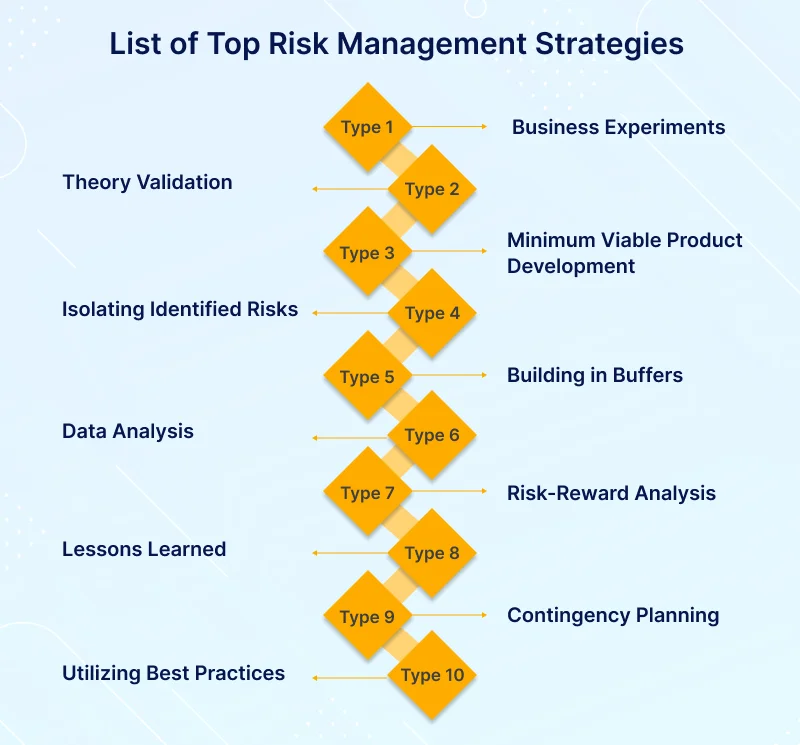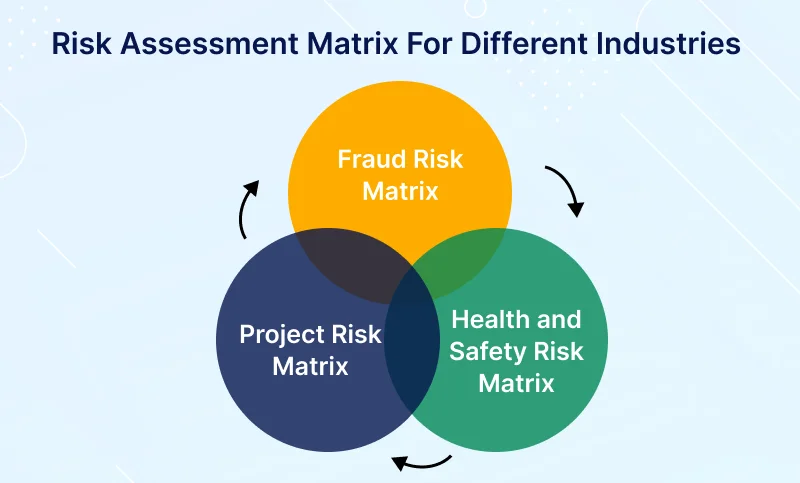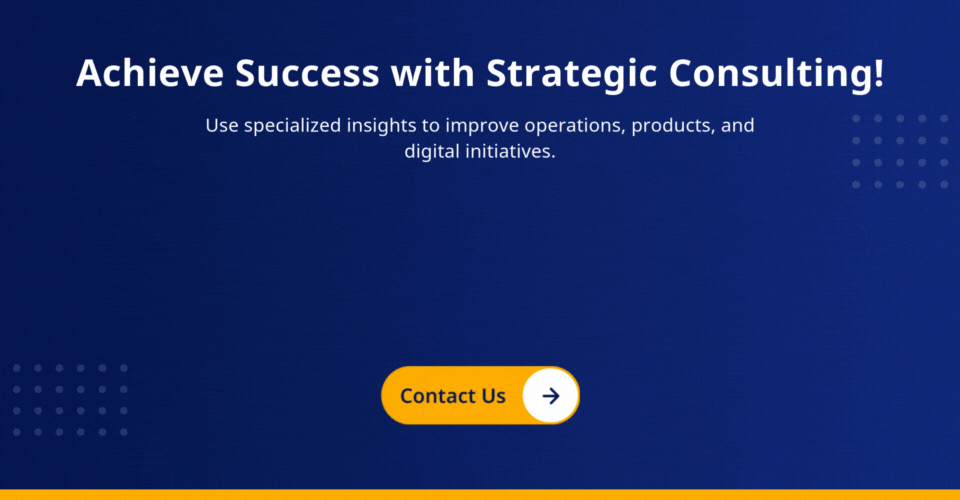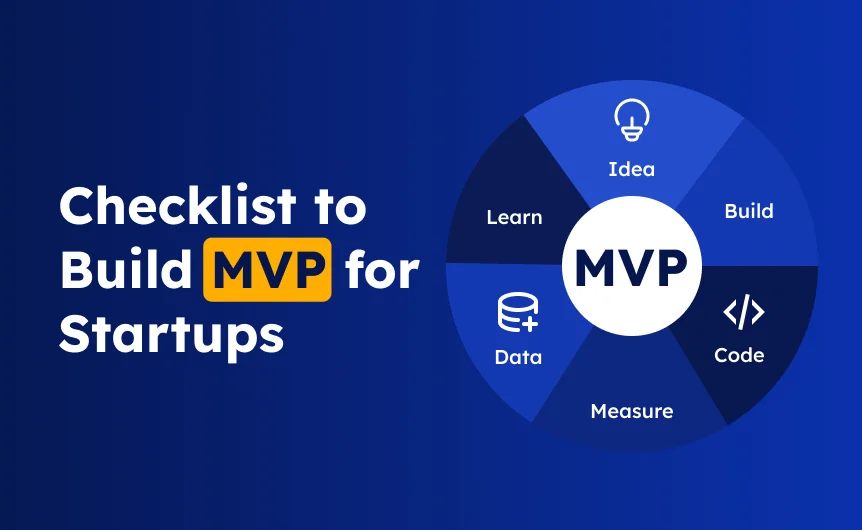In 2016, Uber’s data breach incident revealed the sensitive details of millions of its drivers and users. This resulted in high fines and great damage to their reputation due to poor risk management practices.
Also, Bloomberg News reported that Uber paid hackers around $100,000 to erase stolen data on 57 million individuals.
In the software business landscape, various types of risks (including fraud risk and cyber threats) can adversely affect your company’s reputation. Hence, a risk assessment plan is essential as this impacts software development progress.
Let’s explore various risk types, how to create a risk assessment matrix for a software development project, and how to monitor the matrix to avoid emerging threats.
An Overview of Risk Assessment Matrix
A risk assessment matrix is a visual tool for representing the potential risks affecting a business. This tool helps you understand your risk environment and handle/manage risks in software development before they occur, saving you time, effort, and money.
A risk assessment matrix is based on two intersecting factors:
1. Likelihood (the risk event will occur)
2. Potential impact (the risk event will have)
In simple words, this tool helps visualize the probability against the severity of a potential risk. Once you assess the risk, you can chart it along the matrix to calculate the risk impact.
Key Risk Areas Involved
As an essential part of the project risk analysis process, checking all involved risks in your risk matrix is necessary. Here, we have listed the top risks your business may face:
- Strategic risk: Strategic risks involve performance or decision errors, such as choosing the wrong vendor or software for a project.
- Operational risk: Operational risks are procedural mistakes or process errors, such as inadequate planning or communication breakdown among teams.
- Financial risk: Financial risk encompasses several events that result in a loss of company profit, such as market fluctuations, lawsuits, or competitors.
- Technical risk: Technical risk encompasses anything concerning company technology, such as a security breach, power failure, loss of internet, or property damage.
- External risk: External risks are beyond your control, such as floods, fires, natural disasters, or pandemics.
However, depending on your work sector, you might have to consider other risk types, such as legal and manufacturing risks.
How Does a Risk Assessment Matrix Work?
Since the risks come in various forms, the risk matrix works by showing various risks using charts. These are indicated as color-coded as per the severity of the risks, such as
- Low risks in green
- Moderate risks in yellow
- High risks in red
Depending on the specific business risks, a loss of less than $1K for an insignificant impact or a loss of $1M for a catastrophic impact may occur.
The risk assessment matrix provides a snapshot of the respective business threat by grading the risk event’s likelihood and impact. It further helps compliance managers minimize the events that are more likely to have a substantial impact on the company.
Identify, analyze, and mitigate risks effectively with our tailored risk assessment tools.
Top Benefits of A Risk Assessment Matrix
A risk matrix can help businesses cultivate a solid understanding of the risk environment, helping them manage and mitigate risks before they occur. Find the key benefits here:
1. Helps in Identifying Risks
This is an excellent mental exercise for the organization’s members, making them think about those critical elements for healthy functioning, such as people, operations, resources, etc. See what could hinder your work cycle from continuing.
2. Helps in Prioritizing Risks
It shows how much risk would impact the company, helping the members determine which risk deserves priority attention and channel their resources toward mitigating it.
3. Facilitates Risk Communication
The risk matrix not only lists the risks identified but, in other words, enables all organization members to understand the risks they are exposed to quickly.
4. Empowers Decision-Making
This is a sound ground for informed decision-making, giving accurate data and analysis rather than guessing or intuition.
5. Optimizes Resource Assignment
Once the probability of a risk eventuating and its potential severity have been known, the company may invest more to mitigate them less on those whose impact and probability are lower.
6. Improves regulatory compliance
It enables company members to review internal policies and regulatory protocols to avoid legal and financial consequences.
Use our expertise and proactive approach to identify and mitigate risks, ensuring smooth operations.
Knowing the Probability of Risk Occurrence
Determining the likelihood of a risk occurring is an essential part of the risk assessment matrix. If the probability is calculated wrong, more opportunities will be missed to prevent unnecessary losses.
Let’s understand the probability of risk occurrence using a 5×5 and 3×3 matrix template for a project.
For 5×5 risk matrix,
1. Highly Unlikely
Risks in this category have a minimal likelihood of happening. While their occurrence is rare, they shouldn’t be entirely disregarded.
2. Unlikely
These risks occur with lower probabilities, from 11% to 40%. While less frequent, it makes sense to monitor them to stay away from unanticipated effects on your business.
3. Possible
Possible risks have a moderate likelihood of 41% to 60%. While they may not happen as often, they still warrant attention to prevent potential disruptions.
4. Likely
Risks with a likely categorization have between 61% and 90% chances of occurrence. Such risks require ongoing monitoring and proactive mitigation strategy to effectively address their repetitive nature.
5. Highly Likely
Risks in this category are almost certain to happen, with a probability of 91% or higher. These risks require immediate and thorough attention, as their occurrence is nearly guaranteed.
For 3×3 risk matrix,
6. Unlikely
Risks in this category have a low chance of occurring and require minimal focus unless circumstances change.
7. Likely
These risks are expected to happen with reasonable frequency and require a mitigation strategy to manage their impact.
8. Highly Likely
Risks in this category are nearly certain to occur and necessitate a well-defined plan to reduce their potential harm.
Suppose a company identifies a risk of data theft in a project. After applying the following matrix (as per your business need), the likelihood will be determined as “POSSIBLE,” and the impact will be “MAJOR”.
This risk will be displayed against “POSSIBLE and MAJOR” cells on the matrix template, most falling into the “HIGHLY LIKELY” category. This will cause reputational damage and financial losses to the company.
Also Read – How to Manage Risks in The Software Development Lifecycle
Developing a Risk Assessment Matrix Template In Just 5 Steps
Crafting a risk assessment matrix should not be a complicated process. You can create the risk matrix using tools like a simple Google sheet or Microsoft Excel. However, it is a 5-step process as explained below:
Step 1: Identify Risks
This is one of the most important steps in developing a risk assessment matrix plan. You must a clear picture of the complete risk landscape. This involves finding the involved risks by doing the following activities:
- Review your risk history
- Hold brainstorming sessions with stakeholders
- Check reports from internal & external audits
- Take reports from the risk management team
- Communicate with the employees
These risks include human errors, natural disasters, raw material shortages, cyber threats, regulatory non-compliance issues, and supply chain automation solutions errors.
With advanced analytics, we've identified and mitigated risks, saving clients millions in potential losses.
Step 2: Determine the Likelihood of Occurrence
Now that you have identified the type of risk involved in the project, it is time to determine its probability of occurrence.
Here, you will mark the risk as highly unlikely, unlikely, possible, likely, or highly likely, depending upon the reports of the risk history, geographic location and taking opinion of the risk management experts.
Step 3: Examine the Impact
Once you have identified the likelihood of a risk occurrence, it’s time to determine its impact. This will give you a range on a magnitude scale: insignificant, Minor, Moderate, Major, Catastrophic.
Assessing the severity of a risk for the company involves evaluating how challenging recovery would be and the potential side effects it could create. These effects might include financial losses, damage to reputation, legal disputes, liability issues, or even criminal charges.
Step 4: Establish the Risk Level
To rate each identified risk, use a scale from 1 to 5. This will allow you to prioritize the risk involved and push you to focus on building risk mitigation strategies for the likely events.
Companies can adopt a 3×3 or 5×5 risk assessment template and use best practices to determine the risk’s probability of occurrence and impact/severity.
Step 5: Create the Matrix
This is the final step in creating a risk assessment plan. You need to gather all the above information and pass it to the rest of the teams.
In the first column, list all identified risks (e.g., Risk 1, Risk 2, Risk 3, etc.). Use the adjacent columns to record the frequency of each risk and its potential impact. Populate the cells with the relevant information collected during your analysis.
To create a risk map, enter the probability for each risk in the first cell of each row and the corresponding impact across the columns. Position each risk within the matrix based on its likelihood and severity.
Pro Tip: Apply a color-coding system to highlight risks based on their impact and frequency. For example, use green for low-risk, yellow for moderate-risk, orange for high-risk, and red for critical-risk levels.
Also Read – A Guide to Software Project Management Phases & Best Practices
Top Risk Management Strategies to Follow
A risk assessment matrix helps companies spot and handle possible problems before they happen. This simple but powerful tool maps out risks based on their likelihood and potential impact.
Type 1: Business Experiments
Conducting business experiments allows organizations to test hypotheses in a controlled environment. This approach helps understand potential risks before fully committing resources.
Type 2: Theory Validation
Validating theories through research and testing ensures that the risk assumptions are accurate. This process can help refine strategies and reduce uncertainties.
Type 3: Minimum Viable Product Development
Building a minimum viable product (MVP) enables businesses to deploy an initial, simplified product version. It facilitates gathering feedback from users and understanding risks at an early stage in development.
Type 4: Isolating Identified Risks
Identifying risks and isolating them helps us realize their influence more effectively. Isolation lets teams work on a particular risk without being influenced by other factors.
Type 5: Building in Buffers
Developing buffers in project schedules and costs can be used to reduce the effect of unexpected risks. The approach offers a buffer against delays and cost escalations in projects.
Type 6: Data Analysis
Constant analysis of risk-related data assist organizations in staying clear of potential problems. The approach enables timely risk management processes or strategy adjustments.
Type 7: Risk-Reward Analysis
Evaluating the potential rewards against the risks involved in a project can guide decision-making. This analysis helps determine whether the potential benefits outweigh the risks.
Type 8: Lessons Learned
Recording lessons learned from past projects offers crucial information on risk management. This knowledge can help teams avoid repeating mistakes and improve future project outcomes.
Type 9: Contingency Planning
Having contingency plans allows organizations to be ready for unexpected occurrences. Proactive measures can reduce interruptions and keep project momentum intact.
Type 10: Utilizing Best Practices
Implementing best practices in risk management helps an organization spot and counter risks more efficiently. This is a culture of continuous improvement.
With 20+ years in project risk management, we help businesses identify, assess, and mitigate risks before they escalate.
Examples of Risk Assessment Matrix Catering Different Industries
A risk assessment template is tailored to meet the unique challenges of different industries. The following examples represent how businesses can effectively address specific risks:
1. Fraud Risk Matrix
A fraud risk matrix helps organizations identify and assess the likelihood of fraudulent activities. It categorizes risks based on their potential impact on financial and reputational aspects.
- High Impact/High Likelihood: Credit card fraud, identity theft
- High Impact/Low Likelihood: Internal embezzlement
- Low Impact/High Likelihood: Chargeback fraud
- Low Impact/Low Likelihood: Petty theft
2. Health and Safety Risk Matrix
This matrix is used in industries where health and safety are paramount. It evaluates risks associated with workplace hazards and helps implement safety measures, especially in logistics and transportation software development.
- High Impact/High Likelihood: Workplace accidents, exposure to harmful materials
- High Impact/Low Likelihood: Natural disasters
- Low Impact/High Likelihood: Minor injuries
- Low Impact/Low Likelihood: Equipment failures
3. Project Risk Matrix
A project risk matrix focuses on risks specific to project management. It assesses potential delays, budget overruns, and resource allocation issues that could impact project success.
- High Impact/High Likelihood: Budget overruns, missed deadlines
- High Impact/Low Likelihood: Key team member leaving
- Low Impact/High Likelihood: Minor technical issues
- Low Impact/Low Likelihood: Supply chain delays
Also Read – Custom Software Development Challenges: Alleviate Risk with the Best Practices
Conclusion
A risk assessment matrix is not just paperwork but a vital tool for keeping your business safe and successful. By mapping out possible problems and having plans to handle them, you will be ready for whatever comes your way.
Remember these key points for building effective risk management solutions:
- Keep your matrix simple and clear
- Update it regularly as things change
- Get input from different team members
- Use real data to back up your decisions
- Have specific plans for each major risk
The sooner you map out your risks, the better prepared you’ll be to handle them. Let’s start your journey of building a risk matrix plan with us.
At ValueCoders, we build cutting-edge risk management solutions for our global clients. We help you tackle various challenges such as regulatory compliance, investor communication issues, risk analysis, etc. Contact us today!

